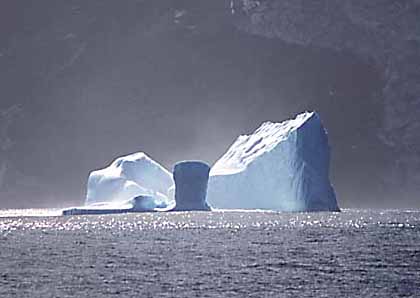The rise in the level is accompanied by a decrease in the salinity of the water, which will lead to an increase in its volume

Additional evidence for global warming is obtained from sea level measurements around Antarctica According to a publication in Nature Geoscience.
.
The researchers explain that according to measurements between 1992 and 2011, the sea level around the continent rose by 8 mm on average every year. This is compared to an average increase of 6 mm worldwide. According to the researchers, this is a clear sign of the increasing melting of the continental glaciers.
The rise in water level is accompanied by a decrease in water salinity. According to researchers from the National Oceanography Center, fresh water is less dense than salt water (lighter) and thus in areas where glacial water flows into the sea there will be a local rise in the level. Despite this, it is difficult to estimate the amount of ice that melted and where it came from.
According to the data of the team of researchers, about 400 billion tons of fresh water are added or melted every year. This addition explains the increased increase in the level. The melting of the continental glaciers also causes the melting of the sea ice surfaces that are tied to them, and thus the salinity of the water decreases again. Most of the melting is observed around the Antarctic Peninsula, the "finger" that points in the direction of South America and the Amundsen Sea.
It is clear that the increased melting of Antarctic glaciers in the last two decades affects the stability of the environment and the Southern Ocean. The melting of Antarctic glaciers is one of the most significant processes as a result of global warming, since Antarctic glaciers constitute the largest accumulation of fresh water in the world and the melting will cause the flooding of many coastal cities.
The flooding of coastal settlements in the entire world is one of the dangers arising from the warming, therefore it is necessary to locate and quantify the speed of the melting. This task is not easy since there are places where the ice layer thickens due to the snow culture.
According to the latest (fifth) publication of the Intergovernmental Panel on Climate Change (IPCC), the melting of the glaciers in Antarctica has increased in recent decades approximately tenfold. This growth causes the sea level to rise and according to various estimates by the IPCC, by 2100 the sea level will rise by 26 to 82 cm.
Encouraging or worrying?

4 תגובות
What's more annoying than a stupid person?
A fool who thinks he's smart...
Very clearly, every phenomenon is a local phenomenon. ISIS is also a local phenomenon in Iraq and Syria...
I wonder if Hadar The honorable man even read the article. Nowhere in the article is the reason for the accelerated melting mentioned, and for good reason: they don't know why there is accelerated melting! There are several good reasons why the authors of the article (who are probably more serious scientists than the aforementioned Daretz Rosenthal) did not write that the reason is "global warming":
1. The Antarctic rock shelf is not "global", it is in a very specific area on our globe.
2. Despite very accurate measurements (actually the most accurate ever), in the last fifteen years or so, no increase in temperatures has been measured, neither of the surface, nor of the sea level, nor of anything.
3. Increased mass can be caused by many climatic factors.
Note also that increased mass does not necessarily mean a decrease in the volume of the glaciers, because they are also filled with snow and frozen rain from precipitation (although in their measurements - backed by computer models whose correctness is questionable - there is indeed an overall decrease in the volume of the glaciers, other measurements do not find such a decrease.
In short, please read the terrifying articles of Dr. Rosenthal with a grain of salt.